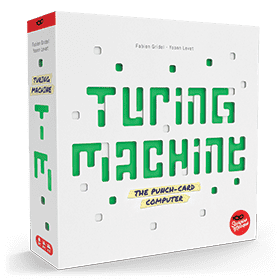Turing Machine
 Turing Machine er et fascinerende og konkurrencepræget udelukkelses spil. Det giver en unik oplevelse af at udspørge en prodotype computer der fungerer uden strøm eller nogen anden form for teknologi, hvorved vejen for en helt ny generation af udelukkelses spil grundlægges.
Turing Machine er et fascinerende og konkurrencepræget udelukkelses spil. Det giver en unik oplevelse af at udspørge en prodotype computer der fungerer uden strøm eller nogen anden form for teknologi, hvorved vejen for en helt ny generation af udelukkelses spil grundlægges.
Målet? Find ud af den hemmelige kode inden de andre spillere ved at udspørge maskinen på den smarteste måde. I Turing Machine anvender du en analog computer med helt unikke hulkort.
Spillet giver mulighed for mere end syv millioner problemer der går fra det helt simple til ekstremt komplekse kombinationer, der gør spillet til en fornøjelse uden afslutning!
Antal spillere: 1 - 12
Spillængde: 8 mn
Kompleksitet: 2 / 5
Spil Turing Machine og 1194 andre spil online.
Ingen download nødvendig - spil direkte fra din webbrowser.
Med dine venner og tusindvis af spillere fra hele verden.
Gratis.

Spil Turing Machine og 1194 andre spil online.
Ingen download nødvendig - spil direkte fra din webbrowser.
Med dine venner og tusindvis af spillere fra hele verden.
Gratis.

Spilsammenfatning
Overview
The objective of the game is to be the first player to correctly solve the code, and with the fewest questions asked, or be the only player not eliminated.
Turn
A turn consists of four or five stages, with each stage carried out simultaneously. The stages are:
- Compose
- Question
- Deduce
- End
- Verification (Not in all rounds)
Compose
In this phase, each player decides on a number for each colour/shape. A number may be used for multiple shapes (e.g. three triangles three squares, two circles).
Question
Players pick up to three of the Verifiers and see how their Proposal meets their criteria.
Two Important Notes:
- The Verifiers do NOT correspond to colors and/or shapes. For example:
- Two Verifiers may contain criteria towards the same colour/shape, or
- A single Verifier may ask if Yellow/Square is Even,
- Another Verifier may ask if Yellow/Square is greater than three)
- The Correct and Incorrect answer received does NOT mean the number is right or wrong, but whether or not your proposal passed for that the Verifier.
Deduce
After completing the Verification step, take some time to figure out (but not declare) if you have found the answer.
End
At the end, count to three, then reveal either a thumbs up (if think you know the code) or a thumbs down (if you are not sure of the code)
If everyone pointed down, return to Compose Phase
If at least one person pointed up, move to the Verification Phase
Verification
The correct code will pass the test of ALL verifiers
If one person is correct, they win!
If more than one person is correct, the person who asked the fewest questions wins!
If no one is correct, they are eliminated!
If the second to last person is eliminated, the final player, even though they did not participate in Verification, will win!
Meaning of verifiers
Each of the verifiers tell you that one of the criteria tested is true or not.
Per example if it exist a verifier which tell you if [(b<3) or (y<3) or (p<3)], that assure you that the color tested is <3. By testing 222, in all games that verifier would return true (so it's useless to ask). If you test 225, it can return true or false. If it return false, then p<3. If it return true, then you don't know if b<3 or if y<3 or if both are true. If you test 555, it will always return false (so it's useless to ask).
Mode
Classic
1 card for each verifier.
Extreme
2 cards for each verifier but only one valid criterion.
Nightmare
You do not know which verifier is associated with which verification card.
Strategy (spoilers)
Each verifier is useful and at the end there is a single solution.
If there is a verifier which test if b<y, b=y, or b>y ; and another test if b<yp, y<bp, or p<by, then if y<bp, that makes the first verifier useless. Same for b<yp. So the second verificator is p<by.
If there is a verifier about the numbers of 4s in the combinaisons, and no others verifiers tell you information about purple, then if p=1, you could have another solution by making p=2. Same for 3&5. So p=4.
For more information, check the following page: Tips turingmachine .

